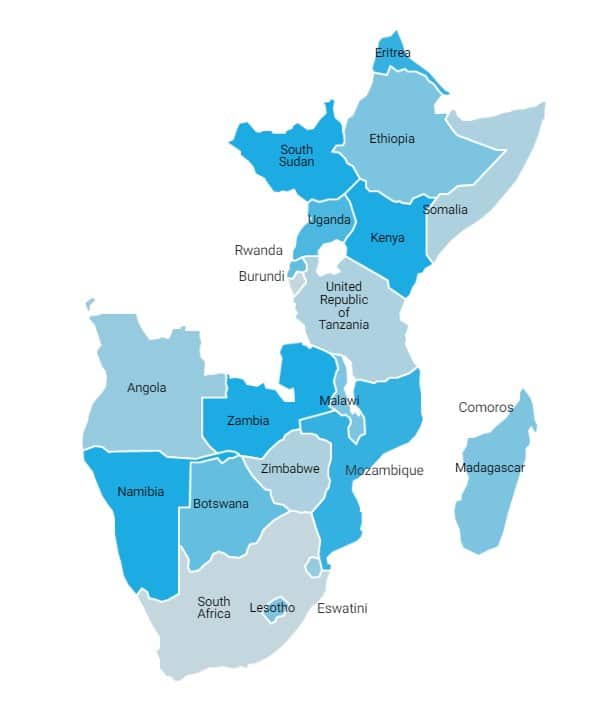Here’s what’s happening around the world in the area of child welfare and protection.

Image courtsey of UNICEF, retrived from: https://www.unicef.org/esa/where-we-work
Research and studies have continually highlighted the importance and benefits of a holistic approach to child protection. UNICEF ESARO commissioned a study to get a better understanding of the status of child protection case management (CPCM) in the 21 ESA countries. The review involved an assessment of strategic documents used in ESA countries to guide child protection case management implementation. It also explored integration of child protection case management, GBV and social protection case management in the form of cash transfers at the implementation level. The documents reviewed for this study included Standard Operating Procedures (SOPs) and tools, training materials, CPCM national frameworks, and evaluations conducted in the countries. This was triangulated with key informant with UNICEF country office staff and questionnaires administered to a few government representatives and UNICEF country office staff.
The review findings suggest that that over time, ESA countries have accessed increasing funding through donor streams (mostly UNICEF and USAID), NGOs and implementing partner firms. With technical support and funding, at least 16 of the 21 ESAR countries have adopted a more holistic approach to child protection case management. This reflects a shift from viewing and implementing child protection case management as a service or single response to a case, to viewing it as a process and tool linking a ‘child in need’ to the different services required for improving the child’s wellbeing.
According to the review findings, in 2020, 16 of the 21 ESA countries had developed frameworks, SOPs and tools to support child protection case management processes. However, these countries were at different stages of CPCM implementation. At the time of the assessment, 12 countries [1] were planning to launch or were rolling out their case management framework, four countries [2] had been implementing their framework for at least four years, while three countries [3] were still developing frameworks.
The review findings highlighted that the case management frameworks were guided by and aligned with international and national legal and policy frameworks. However, coordination and collaboration across country government departments and with implementing partners is still nascent and requires additional support for effective implementation of child protection case management.
At least 12 countries in the region are implementing parallel case management mechanisms for child protection, most developed as per donor requirements or to respond to specific programming or needs of children and not the government led national case management framework [4]. In addition, the countries reported a lack of integration between child protection, gender-based response and social protection case management. While integration of GBV, social protection and child protection case management may be mutually beneficial to the programmes, except for South Africa and Zimbabwe where it is being implemented to a limited extent – no institutionalized integration was found amongst the ESA countries [5]. However, a child grant (Cash and Care) social action service was piloted in Nampula province, Mozambique. This was found to be beneficial to the child protection management process. Notably, there seemed to be a level of integration between GBV and child protection case management in five countries (Malawi, Namibia, Tanzania, Uganda and Zimbabwe) but this appeared to be limited to referral for respective services and data recording in the information management systems.
A shortage of government social service workforce and a heavy reliance on informal community cadres in CPCM implementation was also identified in all the ESA countries. The community cadres play a pivotal role in the identification and monitoring stages of the case management process. Additionally, inadequate training to strengthen the technical capacity of the workforce (both formal and informal) was identified across ESA countries.
The review indicated that CPCM is recognized as important and central to the child protection system across the region. However, despite the need for a coordinated approach across all components of the case management system, findings suggest that emphasis has been placed on the implementation of the case management steps, with limited attention to the structures for supporting, monitoring, and improving case management across the country or area of implementation (at different levels). In addition, while 18 of the countries reported having information management systems [6] there was limited evidence that the information generated was regularly analyzed and used to inform strategic decisions in the respective countries.
In conclusion, the review of the CPCM strategic documents provided evidence of the existing structures, strategies and insights on how they are intended to function, however, it did not provide evidence of implementation or effectiveness of the case management mechanisms. An in-depth review of implementation processes, progress reports and programme evaluation reports could delve into actual implementation, quality of and the effectiveness of case management operations. UNICEF ESARO intends to use the findings from this assessment to support country offices and governments to strengthen child protection case management mechanisms in the ESA countries.
[1] Eswatini, Kenya, Mozambique Angola, Ethiopia, Lesotho, Namibia, Madagascar, Somalia, South Sudan, Uganda, and Zambia.
[2] South Africa, Zimbabwe, Malawi, and Tanzania
[3] Rwanda, Burundi, and Botswana
[4] 12 of the 21 ESAR countries stated that some organizations operate under partner led mechanisms, separate to the national mechanism.
[5] Integration was less explicitly laid out in the frameworks, rather, it was opportunistic, given the potential and existing linkages in some services.
[6] 10 of the ESAR countries rely on paper-based data management systems; 3 are using two systems, paper-based and electronic systems as they transition fully to online systems that provide real-time data and 5 countries use primarily online case management information systems